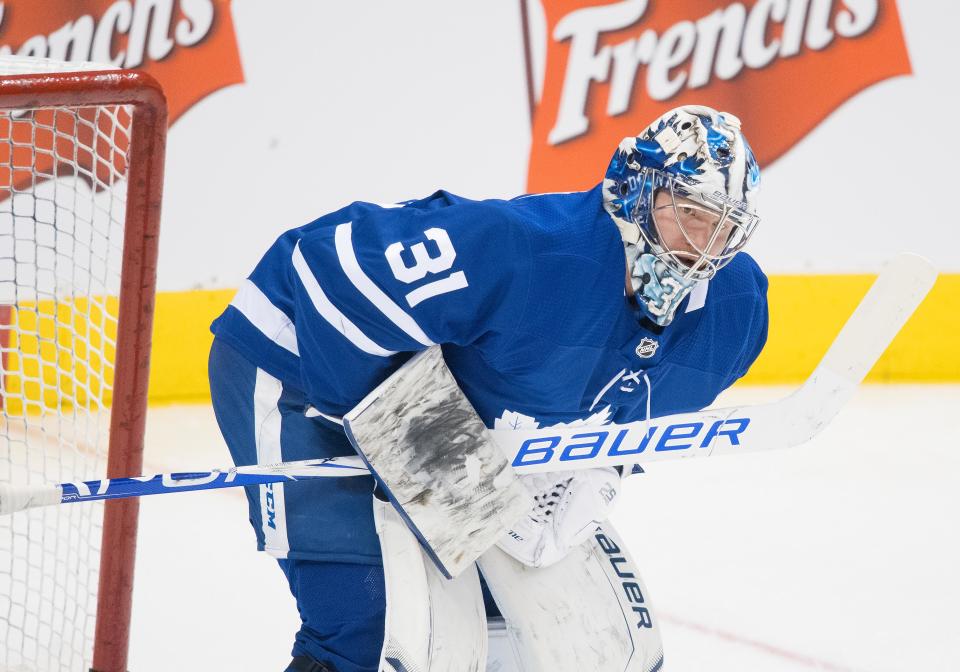How real are the problems facing the Maple Leafs?
So the Toronto Maple Leafs likely didn’t expect to be here, having only banked five wins from 11 games to start the season.
With significant injuries, a bloated and brutal first few weeks of scheduling and just plain-old puck luck, there are factors outside the Maple Leafs’ control that one can point to as contributors to the mediocrity. Yet there are seemingly still very real issues and concerning trends that have surfaced for the Leafs, which must be addressed or at least unpacked for the team to fulfill its potential.
We’ll aim to identify some of those here.
Injuries and Cap Crunch
As Travis Dermott and Zach Hyman near returns from respective major offseason surgeries, two immensely important Leafs will once again be options for head coach Mike Babcock.
The expectation should be that Hyman settles into his second-line function with Mitch Marner and John Tavares — that is, once the captain returns from a broken finger. This means by the midpoint of next month, the most reliable forward unit from the Maple Leafs last season, which delivered a net positive against the most difficult matchups all of last season, should again be fully functional. Meanwhile, Dermott should soon absorb the third-pairing minutes alongside the emerging Justin Holl, forming a potential difference-making tandem from a depth role as a significant upgrade on Martin Marincin. These are good things.
There is an unfortunate cost associated with re-introducing two potential impact players. Two scratches must be made to make room on the active roster, however due to salary implications, it likely means three.
Nic Petan and Kevin Gravel are the obvious candidates for the initial cuts, having played sparingly and passed through waivers this season already, while Martin Marincin is expected to stick around (or in the press box) as the seventh defenseman. It becomes a little more tricky with the other three without obvious assurances: Jason Spezza, Nick Shore and Dymtro Timashov.
To this point, Timashov has outperformed both Spezza and Shore, costs the least and is potentially the least likely between the three to safely clear waivers. But he is also limited from a positional and functional standpoint, being a clear fourth-line winger without a special teams assignment. Timashov has to have established himself as a regular to have value on the roster as he carried little value as a 13th forward. Spezza and Shore just naturally serve a more important function as centres routinely called upon for faceoff duty. You can never really have enough of them in a Babcock system, but there’s a level of redundancy in keeping them both, especially with Frederik Gauthier being trusted on more and more to take draws.
Spezza is the key player to watch through this process. Though it wouldn’t be catastrophic to lose him based on his performance and usage to date, there will be some noting the Leafs’ treatment of veteran players, and potentially applying it to free-agent decisions down the line.
Ugh-tober

How much stress has been on Frederik Andersen and Michael Hutchinson, really?
No team has allowed more shots on net and few teams have spent more time killing penalties through this busy stretch of games in October, so that’s one perfectly reasonable explanation for that fact they, as a tandem, have allowed the most goals against to this point. Yet when measuring the rate for scoring chances and higher-quality looks on net, the more catch-all number in terms of raw goaltending performance speaks less favourably toward their contributions.
The bottom-line is that it’s hard to overcome sub.900 netminding, and that’s what Andersen and Hutchinson have provided through the first three-plus weeks of the season.
While Andersen is responsible for all five wins to this point and Hutchinson has allowed at least four goals in each of his three starts, Toronto’s No. 1 netminder deserves the lion’s share of responsibility for the team’s failure to clear the Mendoza line for goaltenders.
With eight games through the first 20 days of the season, Andersen has had an average of 2.5 rest days between each of his starts, 75 percent of his starts have come on home ice and he has exclusively played behind a team that hasn’t been taxed from the night before. Meanwhile, Hutchinson’s three starts have each come on the second half of a back-to-back with travel further complicating the equation.
Put in the best position to succeed, Andersen has disappointed. Thrown out there with the odds stacked, probability has defeated Hutchinson.
Most encouraging though is that these netminders are simply due to deliver more positive results.
Andersen is a historically slow starter that routinely overcomes uneven Octobers. Hutchinson, meanwhile, has been fine when the Leafs prevent the walls from caving around him, and when he isn’t playing the puck. He might even see a start where he isn’t at a severe disadvantage before the puck is even dropped, which should help him immensely.
Detail, Discipline, Desire... Responsiveness?
More frustrating than the injuries, the lineup decisions, the problems in net and the four sets of back-to-backs in the first three weeks of the season has been the departure of fundamental aspects of the game. For the Leafs, non-negotiables like execution, discipline and effort have been in moments, across sequences, and throughout entire games either inconsistent or nonexistent from some of the most important players on the roster.
Whereas Babcock lost the ability to point to excuses long ago, Auston Matthews and Mitch Marner entered into that same reality when they signed their monster second contracts. And to put it simply, they haven’t been good enough to rationalize their cap-crippling contracts, let alone set the Leafs up to be as special as many believe they can be.
Yes, the points are there. Combined, Matthews and Marner are offering one goal and more than two points per start. But Matthews’ responsibilities in the defensive zone have suffered considerably in the pursuit of the offence, while Marner has struggled to be a positive influence at all at even strength when he’s paid like someone who should drive a dominant line all by himself.
You can’t hang the very clear disorganization in the defensive end on Matthews and Marner, nor can you blame them for Andreas Johnsson’s six minor penalties, Kasperi Kapanen deciding to spike a broken stick at Jeff Petry, or what was a league-high in goals conceded at a point this week.
But the standard is up to the superstars to be set, and it isn’t being raised high enough.
They know this.
“I think we expect more out of each other,” Matthews said after practice Thursday. “That’s just holding everyone accountable, being better moving forward. Put the past in the past and putting our best foot forward.”
Matthews and Marner were included in the leadership core for the first time this season. While maybe without polish in some aspects normally lumped in to a traditional leadership function, they no longer have the option to be without it on the ice.
Until we see that, and how it might impact the rest of the operation, we can’t appropriately evaluate the bigger-picture items potentially at play. Namely, the performance of the coach.
Legitimate limitations?
Assuming the Maple Leafs round into health, Andersen rides his usual trajectory, and the winning details return to the Leafs process, there are still countless questions that need to be asked of this team — most of which can’t be answered with anything more than optimism today.
Can Tyson Barrie have the sort of impact many expected in the absence of meaningful opportunity on the power play? Can William Nylander be productive in isolation from Auston Matthews? Is Cody Ceci so completely miscast as a top-pairing defender that he drags Morgan Rielly’s performance down all season? Can Jason Spezza find traction at all?
Slowly, we’ll begin to have more clarity on these matters before the most important question is asked again:
Has Kyle Dubas constructed the sort of roster Mike Babcock has it in him to win with?
More Maple Leafs coverage on Yahoo Sports

 Yahoo Sports
Yahoo Sports 



